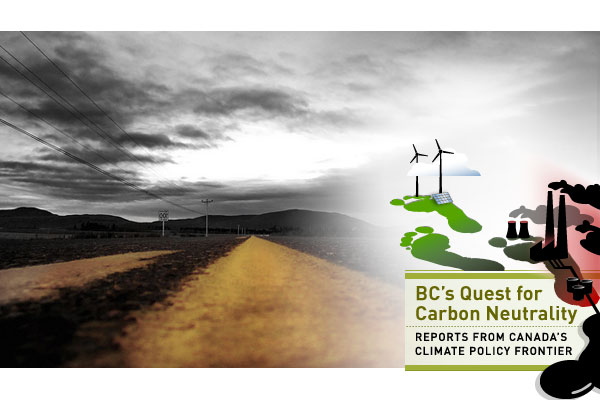[Editor's note: Four years ago, B.C. dazzled the world with a daring new plan to drive down carbon emissions. Well, the world has moved on since 2007 -- through a global financial crisis into a new era of pinched economies and a deepening divide between the economic have-it-alls and the have-lesses (and less and less with each passing year), as expressed in the Occupy movement. Meanwhile, the political leader who gave B.C. its carbon strategy has also moved on. His Liberal successor, Premier Christy Clark, and her equally untested rival, NDP Opposition Leader Adrian Dix, must face British Columbia voters in a general election in May 2013. For both, the millions of dollars in government revenue, public spending, and future tax hikes and disbursements at stake in B.C.'s climate strategy present irresistible, or perhaps inescapable, targets to define their opposing campaigns.
Before the partisan framing sets in, the Tyee Solutions Society thought it might be useful to stand back and consider just what the Climate Action Plan has and hasn't accomplished so far -- what's been learned from its successes and lapses, what informed observers say deserves rethinking and what the rival suitors for our support in the coming election have revealed about which elements of the pioneering plan to zero out B.C.'s carbon footprint they may scrap or enhance.
In this first instalment of a series, Christopher Pollon recaps how we got here. Future instalments will measure partisan support for the Carbon Action Plan; look in on how our unique-in-North-America carbon tax is working out; pull back the curtain on the mysterious world of carbon "offsets"; and more.]
Political observers still can't explain Gordon Campbell's 2007 transformation from eco-villain to trail-blazing climate activist. While other North American politicians stood slack-jawed on the sidelines, British Columbia's then-premier, an avowed enemy of environmentalists, launched the continent's boldest experiment to fight climate change.
Over about a year, Campbell's Liberal government tabled 10 pieces of legislation to enable British Columbia's Climate Action Plan. At its heart was a legally binding requirement to slash B.C.'s greenhouse gas emissions by one-third from 2007 levels by 2020, and 80 per cent by 2050.
Many doubted Campbell's sincerity. Six years earlier, the former Vancouver mayor had terminated his predecessor's climate change program within months of taking power, created a tax loophole for gas-guzzling luxury vehicles and reduced provincial fuel taxes. He joined the premier of oil-producing Alberta in opposing ratification of the Kyoto protocol.
It seemed a stunning reversal when his government's February 2007 speech from the throne declared a four-part war on climate change to include North America's first broad-based revenue-neutral carbon tax, mandatory public sector carbon neutrality and plans for participation in a regional cap and trade system.
The boldness of B.C.'s climate plan continues to astonish international politicians and business leaders. "They're all dumbfounded," said Mark Jaccard, an environmental economist at British Columbia's Simon Fraser University, International Panel on Climate Change (IPCC) co-author and one of the experts recruited late in 2007 to help the province meet its ambitious 2020 targets. "They're like, 'You did that? What political leader would have done that? This is crazy!' "
Crisis = opportunity
What appears to have inspired Campbell's conversion was a combination of global theory and painful local experience -- and a pragmatic conclusion that global climate crisis would yield vast economic opportunities for the province.
Known as a policy wonk, Campbell was profoundly affected by the 2006 Stern Review, which warned that 20 per cent of global gross domestic product (GDP) could be lost by climate inaction. The cost of action was, by contrast, estimated at just one to two per cent of the global GDP. "The economic benefits opened up by transitioning to a low-carbon economy are real and substantial," Campbell's "Climate Action Team" wrote of the Stern Review.
Sobering realities on the ground bolstered the resolve to act. By 2007, it was difficult to deny the role of warmer winter temperatures in a mountain pine beetle epidemic that had already killed at least 530 million cubic metres of interior lodge-pole pine, with no end in sight. In the space of a generation, a province dependent on the flow of its great rivers for electricity had lost up to half of its snowpack.
At the time -- with the fourth report from the IPCC being widely reported, former U.S. vice-president Al Gore's Inconvenient Truth in theatres and the Great Recession still to come -- public concern was also ascendant. An Ipsos-Reid poll three months before the launch of the climate plan showed the issue eclipsing even health care as a concern for Canadians.
The making of a plan
By all accounts, B.C.'s climate strategy was devised and implemented quickly, vetted only by a small circle of people close to the premier and the finance and environment ministries. Outsiders who provided advice included Jaccard and another IPCC co-author, Andrew Weaver, climate scientist at the University of Victoria. (Weaver gained notoriety last year when he sued several climate-change-skeptical Canadian columnists who had publicly questioned his professionalism.)
British Columbia's emissions targets became law in November 2007, followed seven months later by the release of a Climate Action Plan to achieve them. (See a more detailed timeline in the fact box to the right of the story.)
Hitting those carbon goals would, however, as Campbell's advisors warned, require nothing short of a revolution in thinking: "What we are driving... is perhaps the largest and most significant shift in public attitudes ever," the Climate Action Team wrote in 2008. "We are attempting to alter, in the span of just a few years, behaviours that in many cases have been entrenched for generations."
Four pillars
To achieve its revolution, B.C.'s Climate Action Plan, released in June 2008, relied on four pillars:
A carbon tax. The carbon tax put a dollar price on carbon emissions. Starting in July 2008, that price was C$10 per tonne of CO2 equivalent emissions, designed to increase by C$5/tonne annually until 2012, when it will hit C$30/tonne. The tax is applied and collected at the wholesale level in the same way as most motor fuel taxes and was designed to be "revenue neutral" -- almost all of the revenue collected is offset as tax cuts. By raising the cost of fossil fuels, the tax is intended to provide an incentive to find less carbon-intensive energy and transportation alternatives. Emissions from certain industrial processes, like gas flaring and certain aspects of aluminum and concrete production, remain exempted from the carbon tax.
A low-carbon fuel standard. Legislation mandated a 10 per cent reduction in the "average carbon intensity" of fuels used in B.C. by 2020. To make this happen, fuel distributors are required to calculate the average "global warming intensity" of their products -- including emission-creating activities during their production (such as refining and stack flaring) -- and reduce it over time.
Public sector carbon neutrality. In another continental first, all activities in British Columbia's public sector -- a category that includes government offices, provincial jails and public schools, as well as hospitals and Crown corporations (of which the biggest is BC Hydro with C$4 billion in revenues last year) -- were ordered to become "carbon neutral" by 2010. How? A covered entity such as a Crown corporation had first to calculate its total business-as-usual greenhouse gas emissions, then reduce those as much as possible. And emissions that remain must be "offset" by the purchase of carbon-reduction credits from the Pacific Carbon Trust, a new Crown corporation created specifically to acquire and sell a portfolio of "made-in-B.C." carbon offsets. In 2010 alone, the provincial public sector spent C$18.2 million annually to offset 730,000 tonnes of greenhouse emissions.
Regional cap and trade. B.C. was the first province to fully partner in North America's Western Climate Initiative (WCI), which is designing a regional cap and trade system to be formally launched in January 2012. Such a system imposes a limit or "cap" on the total emissions for participants in the system, lowering the cap over time with the goal of meeting an overarching reduction target. Individual emitters are issued credits equal to the amount of emissions allowed under the cap. If a participant cannot meet their own emissions limit, they must either purchase additional credits from participants that are successful in meeting their emissions target, or invest in emissions-reducing projects.
The Western Climate Initiative got a critical boost in October when California approved its final cap and trade regulations which will enable the trade of emission credits by 2013. Quebec is firmly committed to participate as well. Just last week, however, WCI took a hit when six American states pulled out of the program.
Uncertain future
Nearly five years after it began, B.C.'s bold experiment in change is at a crossroads. Campbell has gone off to a plum diplomatic posting in London.
His successor, Premier Christy Clark, is struggling to solidify her leadership in the lead-up to an election prescribed by law for May 2013. She has made the family her policy priority ahead of the environment, and counts among her closest advisers the founding CEO of one of the continent's largest natural gas producers.
Clark's opposition in the B.C. legislature is under new leadership of its own, as Adrian Dix aims to place his stamp on New Democratic Party policy before the province votes.
Staying the present course is not an option for either leader. Round one of actions under the Climate Action Plan was never designed to take us more than about 75 per cent of the way toward our 2020 emissions reduction target. The plan contemplated a second round, kicking in sometime around now, to take us the rest of the way. Round two would include:
- Possible increases to the carbon tax after 2012 if required to achieve emissions targets.
- Expanding the carbon tax to include all greenhouse gas emissions generated in B.C., or capturing these "fugitive" industrial emissions as part of a future cap and trade system.
- Increasing the carbon fuel standard to 15 from 10 per cent by 2020.
- Capturing emissions from air travel in the new cap and trade system after 2012 -- or, barring that, "mandatory carbon credit payments" charged at points of air travel.
How many of those will survive the politicking to come? Or will British Columbia follow other jurisdictions and retreat back to the sidelines? Perhaps the most important questions of all: Which parts of B.C.'s pioneering climate plan are actually delivering reduced carbon emissions? And which, if any, are not?
We'll be examining those questions over the days and weeks ahead in this special series of reports on B.C.'s embattled commitment to carbon cutting.
Tomorrow: Tom Barrett takes the measure of Carbon Plan support -- or not -- in today's post-Gordon Campbell politics.
[Tags: Environment, Energy, Politics.] ![]()
Read more: Energy, Politics, Environment


















Tyee Commenting Guidelines
Comments that violate guidelines risk being deleted, and violations may result in a temporary or permanent user ban. Maintain the spirit of good conversation to stay in the discussion.
*Please note The Tyee is not a forum for spreading misinformation about COVID-19, denying its existence or minimizing its risk to public health.
Do:
Do not: